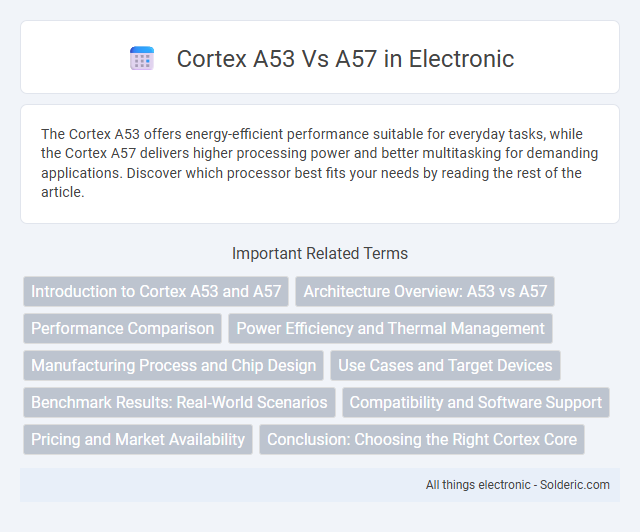The Cortex A53 offers energy-efficient performance suitable for everyday tasks, while the Cortex A57 delivers higher processing power and better multitasking for demanding applications. Discover which processor best fits your needs by reading the rest of the article.
Comparison Table
| Feature | Cortex A53 | Cortex A57 |
|---|---|---|
| Architecture | ARMv8-A, 64-bit | ARMv8-A, 64-bit |
| Performance | Low-power, efficient | High-performance, power-hungry |
| Cores | Up to 8 cores | Up to 4 cores |
| Frequency | Up to ~1.5 GHz | Up to ~2.5 GHz |
| L1 Cache | 32 KB Instruction + 32 KB Data | 48 KB Instruction + 32 KB Data |
| L2 Cache | 256 KB per core | 2 MB per core |
| Pipeline | In-order, 8-stage | Out-of-order, 15-stage |
| Power Efficiency | High efficiency for low power devices | Higher power consumption, focused on performance |
| Use Case | Mobile, entry-level devices | High-end smartphones, tablets |
Introduction to Cortex A53 and A57
The ARM Cortex-A53 is a power-efficient 64-bit processor core designed for budget and mid-range devices, offering a balance between performance and low energy consumption. The Cortex-A57, on the other hand, delivers higher performance with a 64-bit design optimized for premium devices requiring advanced processing capabilities. Understanding the differences between these cores helps you choose the right architecture for applications prioritizing either energy efficiency or superior computational power.
Architecture Overview: A53 vs A57
The ARM Cortex-A53 features a 64-bit, energy-efficient, in-order architecture optimized for low power consumption in mobile and embedded devices. In contrast, the Cortex-A57 employs a 64-bit, out-of-order superscalar architecture designed for high-performance computing, offering enhanced instruction-level parallelism and improved branch prediction. The A57's pipeline depth and advanced execution units provide significantly higher throughput compared to the simpler, more power-conscious design of the A53.
Performance Comparison
The Cortex-A57 delivers significantly higher performance than the Cortex-A53, boasting up to 60% more processing power thanks to its out-of-order execution and higher clock speeds. Designed for heavy-duty tasks and complex applications, the A57 excels in 64-bit processing, whereas the energy-efficient A53 targets low-power and mid-range devices with in-order execution. Your choice between the two should depend on whether you prioritize raw performance or power efficiency for your specific application.
Power Efficiency and Thermal Management
The Cortex-A53 delivers superior power efficiency through its 28nm and 16nm process designs, making it ideal for low-power and thermal-sensitive applications compared to the Cortex-A57. The Cortex-A57, built on a larger, more power-hungry process node, achieves higher performance but generates significantly more heat, requiring advanced thermal management solutions. Optimizing for power efficiency and thermal constraints often leads designers to favor the Cortex-A53 for mobile and embedded systems where prolonged battery life and cooler operation are essential.
Manufacturing Process and Chip Design
The Cortex-A53 utilizes a 28nm manufacturing process optimized for energy efficiency and cost-effectiveness, while the Cortex-A57 employs a more advanced 20nm process offering higher performance and power efficiency. Chip design differences include the Cortex-A53's in-order execution for low power consumption, contrasting with the Cortex-A57's out-of-order execution that boosts processing speed and supports more complex tasks. Your choice between the two depends on whether energy efficiency or raw performance is the priority in your device.
Use Cases and Target Devices
The Cortex-A53 is tailored for energy-efficient smartphones, tablets, and entry-level IoT devices, offering balanced performance for everyday tasks and prolonged battery life. The Cortex-A57 targets high-performance applications in premium smartphones, tablets, and embedded systems requiring advanced processing power for gaming, multimedia, and heavy multitasking. Device manufacturers often pair Cortex-A53 cores with Cortex-A57 in big.LITTLE configurations to optimize power consumption and deliver scalable performance across diverse workloads.
Benchmark Results: Real-World Scenarios
The Cortex-A57 delivers significantly higher performance than the Cortex-A53 in real-world benchmark tests, excelling in multi-threaded applications and heavy workloads due to its out-of-order execution and higher clock speeds. Benchmarks like Geekbench and SPECint consistently show the A57 outperforming the A53 by approximately 40-50% in processing power, making it ideal for demanding tasks such as gaming and video editing. Your choice between these cores should align with performance needs and power efficiency preferences, as the Cortex-A53 offers better energy savings while the Cortex-A57 targets superior computational capability.
Compatibility and Software Support
The Cortex-A53 offers extensive compatibility with a wide range of operating systems and software due to its ARMv8-A architecture and 64-bit support, ensuring better future-proofing for your devices. In contrast, the Cortex-A57, while also supporting 64-bit ARMv8-A, was designed for higher performance and may encounter limitations with some legacy 32-bit applications. Software support for the Cortex-A53 is broader, making it more versatile for applications targeting diverse and evolving software ecosystems.
Pricing and Market Availability
The Cortex A53 is widely available and often used in budget-friendly devices due to its lower manufacturing costs, making it an economical choice for mass-market smartphones and IoT products. In contrast, the Cortex A57 targets high-performance markets with a higher price point, primarily seen in premium smartphones and tablets where processing power is prioritized. Your decision between these two should consider the balance between cost efficiency and performance needs in your device lineup.
Conclusion: Choosing the Right Cortex Core
Cortex-A57 offers significantly higher performance and better efficiency for demanding applications due to its out-of-order execution and larger cache, making it ideal for high-end smartphones and tablets. Cortex-A53 is optimized for low power consumption and cost efficiency, suited for entry-level devices and tasks with less intensive processing needs. You should choose Cortex-A57 for superior speed and multitasking, while Cortex-A53 fits best when battery life and affordability are your primary concerns.
cortex a53 vs a57 Infographic

 solderic.com
solderic.com